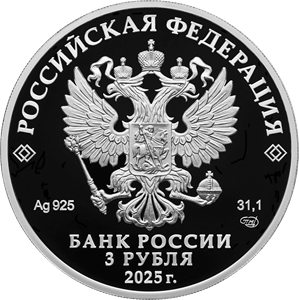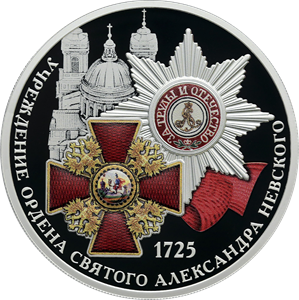The 300th Anniversary of the Establishment of the Order of Saint Alexander Nevsky
Obverse
a relief image of the National Coat of Arms of the Russian Federation, above it along the rim the inscription in a semicircle ‘РОССИЙСКАЯ ФЕДЕРАЦИЯ’ (RUSSIAN FEDERATION) framed with paired diamonds on both sides, under the coat of arms are the chemical symbol and fineness of the metal on the left and fine metal content and the mint mark on the right, at the bottom centre in three lines are the inscription ‘БАНК РОССИИ’ (BANK OF RUSSIA), the coin denomination ‘3 РУБЛЯ’ (3 RUBLES), and the year of issue ‘2025 г.’ (2025).
Reverse
relief coloured images of the badge and the star of the Order of Saint Alexander Nevsky, a folded ribbon against the background of an image of a fragment of the Holy Trinity Cathedral of the Alexander Nevsky Lavra, laser treated for matte finishing; and the relief inscriptions below ‘УЧРЕЖДЕНИЕ ОРДЕНА СВЯТОГО АЛЕКСАНДРА НЕВСКОГО’ (THE ESTABLISHMENT OF THE ORDER OF SAINT ALEXANDER NEVSKY) around the circumference and ‘1725’ above it.
Authors
Designers: E.V. Kramskaya (obverse), A.A. Brynza (reverse).
Sculptors: A.A. Dolgopolova (obverse), A.A. Brynza (reverse).
Mint: Saint Petersburg Mint (СПМД).
Edge: 300 corrugations.
Discover more
The Order of Saint Alexander Nevsky was first awarded on 21 May (1 June) 1725. Envisioned by Peter the Great and introduced by Catherine I, this Order became the third one established in the Russian Empire. According to the will of Peter the Great, this order was to become Russia’s main military award, but Catherine I decided to introduce the new award as a single one for both military and civil achievements. Thus, the Order ranked only behind the Order of Saint Andrew the Apostle and the women’s Order of Saint Catherine.
Many eminent persons received this award, including Field Marshals, such as Pyotr Rumyantsev, Alexander Suvorov, and Mikhail Kutuzov; Generals, such as Nikolay Raevsky and Mikhail Miloradovich; Admiral Fyodor Ushakov; statesman Aleksei Musin-Pushkin; and geographer and explorer Pyotr Semenov-Tyan-Shansky.
The Order’s motto was ‘For Labour and the Fatherland’. The badge of the Order was a cross pattée with distinctive double-headed eagles placed between the cross ends. The centre of the cross featured an image of Alexander Nevsky on horseback inside a circular frame. The cross was worn on a red moire sash put over the left shoulder. The star was worn on the left side of the chest.
The Order of Saint Alexander Nevsky was abolished after the October Revolution of 1917 just as all other awards of the Russian Empire. In July 1942, the USSR introduced a new Soviet Order of Alexander Nevsky for awarding Red Army commanders of various levels.
The modern Russian Order of Alexander Nevsky is very similar in design to that of the Russian Empire, and like the imperial one, it may be conferred on civilians as well. The Order of Alexander Nevsky can be awarded to citizens of the Russian Federation to commend their long-term meritorious service to the Fatherland, great achievements in economic development, science, education, culture and art, healthcare and other fields, as well as for strengthening Russia’s international prestige and defence capabilities, notable personal achievements in various areas of socially useful activity. The Order can also be awarded to clerics.
Sources: https://historyrussia.org, https://histrf.ru, https://znanierussia.ru


